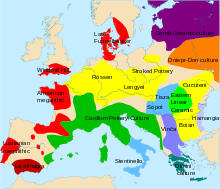Dnieper-Donets culture
 |
|
| Geographical range | Eurasian Steppe |
|---|---|
| Dates | c. 5000 BC – 4200 BC |
| Preceded by | Swiderian culture |
| Followed by | Funnelbeaker culture |
The Dnieper–Donets culture (ca. 5th—4th millennium BC) was a Mesolithic culture in the area north of the Black Sea/Sea of Azov between the Dnieper and Donets River, and bordering the European Neolithic area.
There are parallels with the contemporaneous Samara culture. The Dnieper–Donets culture was succeeded by the Yamna culture.
It was a hunter-gatherer culture that made the transition to early agriculture. The economic evidence from the earliest stages is almost exclusively from hunting and fishing.
Inhumation was in grave pits, with the deceased being covered in ochre. Burial was sometimes individual, but larger groupings are more common, with burials being carried out sequentially in the same grave.
There are parallels with the contemporaneous Samara culture, and a larger horizon from the lower half of Dnieper to the mid-to-lower Volga has been drawn, particularly by the advocates of the Kurgan hypothesis as expounded by Marija Gimbutas. Dmitry Telegin () assigns them to a broad cultural region that spanned the Vistula in Poland southeast to the Dnieper. Mallory includes this area within the limits of the Proto-Indo-Europeans. The precise role of this culture and its language to the derivation of the Pontic-Caspian cultures such as Sredny Stog and Yamna culture, is open to debate, though the display of recurrent traits points either to long-standing mutual contacts or underlying genetic relations.
The physical remains recovered from graves have been described as typically Europoid. They are predominantly characterized as late Cro-Magnons with more massive and robust features than the gracile Mediterranean peoples of the Balkan Neolithic.
...
Wikipedia
